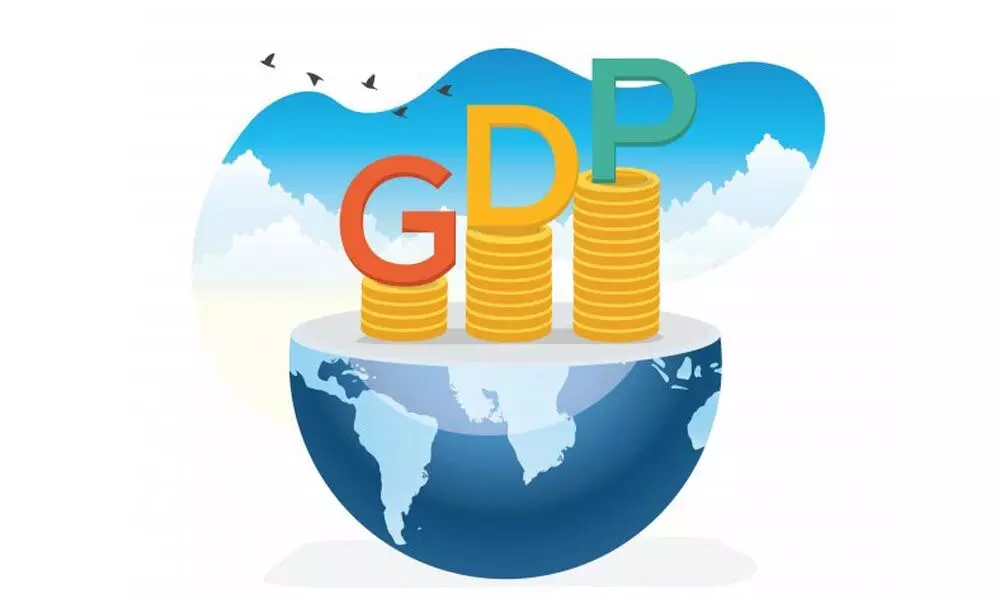9% economic growth come-at-able for India
However, economists remain wary of the fading global demand and the uneven recovery across sectors
image for illustrative purpose

Mumbai: In spite of hurdles like stressed rural economy, India is all set to achieve the GDP growth rate of 9 per cent in the current fiscal, feel the economists.
Of course, this growth rate was likely to be achieved by the factors like improved vaccination drive, festive demand and government spending.
However, economists remain wary of the fading global demand and the uneven recovery across sectors. Meanwhile, even though inflation is expected to remain tepid in the near term, we expect price pressures from services-led inflation, lagged pass-through of global commodity prices and demand revival to weigh on the medium-term inflation outlook. Talking to Bizz Buzz, Madan Sabanavis, chief economist, Care Ratings, says: "There are lots of indicators that do show that recovery was happening with the opening up of the country's economy, which was service-oriented one, and we do expect to achieve a GDP growth at 9-9.2 per cent for the current fiscal."
Recovery was all set to happen in the services sector too. We are banking on minimum revival of demand which means an increase in demand for consumer goods and that should work out. The first half financial results of corporates are good and they do hope to see better sales in the second half of the current fiscal. The only concern was that of rural demand. Still, I do believe that it is not going to be a major concern, he said. Yield curve, the economists believe, would flatten as RBI begins the exit, but better fiscal situation to cap long end. As the economy recovers gradually with inflationary risks skewed towards the upside, the RBI has stealthily begun their course of policy normalization.
"We expect the RBI's key objective will be to ensure shifting of the operating target rate closer to repo rate through increasing quantum and tenure of VRRRs, sterilizing incremental liquidity surplus, normalizing the policy corridor (from February), withdrawing durable liquidity surplus, changing monetary policy stance to neutral and repo rate hike," said Upasna Bhardwaj, an economist with Kotak group.
According to Bhardwaj: "We expect the liquidity fine-tuning measures to continue to weigh on the shorter end of the curve. However, favourable borrowing pattern and expected operation twists should help cap sharp upside to yields. We expect 10-year yield to inch higher towards 6.4-6.5 per cent by end of March."
India's growth outlook looks promising for now with a quick rebound from the lows. However, the scarring in the bottom to middle of the consumer pyramid could have some medium-term impact on consumption even if it does not affect near-term consumption. Further, global demand will also normalize, which will be a drag on net exports. A reversal in the interest rate cycle and liquidity conditions over the next 4-6 quarters along with a lower fiscal impulse will be drags on
growth. However, with a rapid pace of vaccination, the services sector should start picking up soon, which should keep near-term growth on a steady footing. The external sector balance remains comfortable but sustained increases in crude prices along with any reversal in global
flows will weigh on the INR although the RBI has enough fire power to stand against any strong and sustained depreciation.
"We detail our views on growth, inflation, public finance, monetary policy, interest rates, and FX movements below," says another economist with the group, Suvodeep Rakshit.
"We expect FY2022 real GDP growth at 9 per cent on expectations of higher sequential growth in 2HFY22 as the proportion of fully vaccinated population picks up pace, limiting any potential adverse side effects from Covid infections," he added.
Further, the export sector, which was a key engine of growth in 1HFY22, is likely to lag going ahead given the fatigue witnessed in global demand. Also, persistence of the pandemic-induced supply bottlenecks and the zero-tolerance Covid-related policies globally, which continues to disrupt supply chains will weigh on the growth outlook.
On the domestic front, government spending has not been a great support until now (cash balances as of now estimated at around Rs 4.3 tn). Going ahead, economists expect government spending, especially capex, to be one of the key drivers of growth in 2HFY22. The general
government has budgeted around 10 per cent expenditure growth in FY2022 and have delivered 7.2 per cent in 5MFY22.
However, improving consumer confidence, strong agriculture production estimates, along with improvement in employment situation, provide hope of a strong revival in festive demand and hence continued sequential pickup in near-term growth. However, the surge in global commodity prices, fading global demand, semi-conductor shortages amid risk of power crisis may temper near-term growth outlook.
Kotak study maintains its base-case real GDP growth of 9 per cent in FY2022, which will be just about at par with the FY2020 real GDP level and around 10 per cent below non-pandemic GDP trend size.
India's inflation trajectory has seen impact of these global commodity prices as well as domestic lockdowns during the first and second waves. In FY2021, CPI inflation breached the 6 per cent upper tolerance mark for eight consecutive months (April-November 2020).
FY2021 average headline CPI was at 6.3 per cent, led largely by supply bottlenecks, high duty structure across petroleum products and edible oils, and elevated global commodity prices. After a brief moderation in inflation in 4QFY21 (4.9 per cent compared to 6.6 per cent in 9MFY21), the second wave-induced lockdown restrictions again pushed CPI inflation higher towards 5.6 per cent in 1QFY22. The favorable base effects have aided the inflation trajectory downwards since then.

